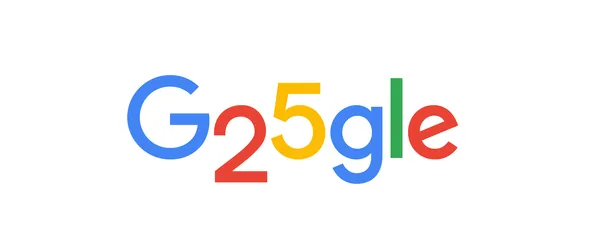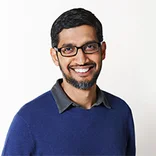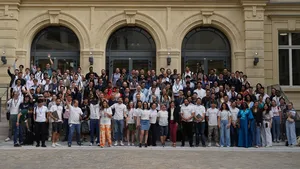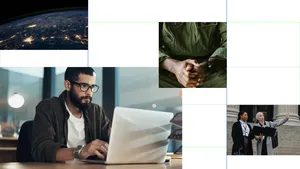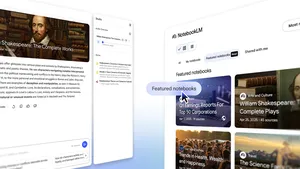Questions, shrugs and what comes next: A quarter century of change

Editor’s note: Google will officially celebrate our 25th birthday later this month. To kick off celebrations, Google and Alphabet CEO Sundar Pichai reflects on our first quarter century, including the questions and technological advancements that led to our biggest breakthroughs and most helpful products. He also shares some thoughts on the opportunity we have with AI to do things that matter on an even bigger scale.
To everyone around the world who uses our products, our employees, and our partners:
This month, Google will celebrate our 25th birthday. It’s a huge privilege to reach this milestone, made possible by the people who use our products and challenge us to keep innovating, the hundreds of thousands of Googlers past and present who have given their talents to building those products, and our partners who believe in our mission as much as we do.
It’s a time for some gratitude, and a moment to reflect.
I’ve been thinking a lot about how far technology has come over the last 25 years and how people adapt to it. Years ago, when I was studying in the U.S., my dad — who was back in India — got his first email address. I was really excited to have a faster (and cheaper) way to communicate with him, so I sent a message.
And then I waited…and waited. It was two full days before I got this reply:
“Dear Mr. Pichai, email received. All is well.”
Perplexed by the delay and the formality, I called him up to see what happened. He told me that someone at his work had to bring up the email on their office computer, print it out, and then deliver it to him. My dad dictated a response, which the guy wrote down and eventually typed up to send back to me.
Fast forward to a few months ago: I was with my teenage son. He saw something interesting, took some quick pictures and shared them with his friends. Then they exchanged a few messages, and it all seemed faster than the time it would take me just to pull out my phone.
How I communicated with my dad all those years ago compared with how my son communicates today shows just how much change can happen across generations. Technology that takes us years to adapt to is second nature for our kids. Ideas my dad marveled at as science fiction — taking a call from your watch, or telling your car to play your favorite song — make my children shrug.
Those shrugs give me great hope for the future. They set a high bar for what the next generation will build and invent...and I can’t wait to see what will make their children shrug, too.
An essential truth of innovation is that the moment you push the boundary of a technology, it soon goes from extraordinary to ordinary. That’s why Google has never taken our success for granted.
It all started with a search
Larry and Sergey first wrote down our mission 25 years ago: to organize the world’s information and make it universally accessible and useful. They had an ambitious vision for a new kind of search engine to help people make sense of the waves of information moving online. The product they built, Google Search, went on to help billions of people around the world get answers to their questions.
For a few years, I was one of those people experiencing Google like any other user of the web. I remember feeling blown away by Google’s ability to find the best answer for the most esoteric questions, from a tiny detail buried in a store’s customer service page to an obscure football rule.
The questions I’ve asked Google have evolved over time: “How do you fix a dripping faucet?” “Fastest route to Stanford Hospital?” “Ways to calm a crying baby?” And right around spring of 2003, perhaps: “How to ace a Google interview?” And over time, Google got much better at answering them.
It’s been inspiring to see what people have done with the answers to their questions, be it to find health care or comfort in difficult times, learn new skills, pursue new career paths, or start new businesses. The idea that a student in rural Indonesia could access the same information as a professor at Stanford was revolutionary, and has changed lives and our world for the better. It’s opened up access to education and entrepreneurship like nothing else before it, or since.
Search also laid the foundations for Google to make an economic impact beyond our own walls. Our advertising platforms and tools started out with a premise as simple as Search itself: to help businesses reach customers who were already looking for the kinds of products and services they offer. It was a platform that appealed to small businesses in particular, like the mail-order business selling lobsters that was the first to sign up. And also like Search itself, the ability for any business to advertise online has had a truly transformational impact, helping millions of businesses become part of the digital economy.
A quarter century of questions
Search is still at the core of our mission, and it’s still our biggest moonshot with so much more to do.
Of course, Google today is more than a search box. We have 15 Google products that each serve more than half a billion people and businesses, and six that serve more than 2 billion users each.
Like most Google searches, all those products started with a question, too. With Gmail it was Could we offer 1 GB of storage to every person? In 2004, when Gmail launched, that volume of storage was over 100X what most other free webmail services were offering!
Then a few years later, we saw an opportunity to dramatically improve web browsers — and in turn the web — for people everywhere. So with Chrome we asked: Could we build a browser that made the web better, with simplicity, speed, and security at its core? Right before launch, I had my own question: Will people use this?
YouTube dared to ask: What if we gave everyone a way to share what they know with the world? And today, it’s become a powerful platform for learning and knowledge.
The questions have kept coming, and we’ve kept improving and expanding our products with new answers: What if Google Maps enabled people to see every street in the world in detail? What if we built a translation tool that allowed people to access information, and communicate in multiple languages? What if you could search and find all your old photos by simply describing what you wanted to see?
We’ve also asked ourselves how we could best share our tools, breakthroughs, and infrastructure with others. Google was built in the cloud from the start, even though we only launched our Cloud business in 2008. Today, Google Cloud has become one of the top enterprise companies in the world. Partners across industries are using Google technology to improve customer support and supply chain efficiency, reduce their carbon footprint, build new applications, and get more done with AI. Like our advertising clients before them, Cloud’s partners are operating better, growing faster and creating jobs, with our help.
Of course, not every question we asked ended up as a success. In any 25-year journey, you take a few lumps, learn the lessons and work to do better. Remember Google Wave?
We’ve also faced hard questions about our future as a company. In the 2000s it was how long can the web really last? In the 2010s, people asked if we could adapt to the era of mobile computing, and whether search was “over?” Each time, we’ve answered by coming back even stronger. We’ve done this guided by a singular focus on our mission, our belief in applying deep computer science to make people’s lives better, and a healthy disregard for the impossible.
A healthy disregard for the impossible
That healthy disregard is why we’ve been able to take on problems others couldn’t — or wouldn’t. There was, for example, this impossible idea of putting a powerful computer in everyone’s pocket, no matter their income or internet connectivity. Today, Android runs on 3 billion devices all over the world, from the latest foldables to entry-level phones. It’s been at the core of our efforts to make the internet more accessible for everyone, and inspired other, transformative products. Likewise, Chromebooks made computing available to schools all over the world. And Google Pixel puts the best of our latest technology — machine learning-powered cameras, speech recognition, transcription capabilities, tensor chips and more — directly into people’s hands.
Which brings us to AI. Google has been investing in AI since almost the beginning. We were one of the first to use machine learning in our products, starting in the early 2000s, for spelling corrections, improving the quality of ads, and showing suggestions and recommendations.
Then, in the early 2010s, there was real excitement around deep neural networks. In 2012, a few of us went along to a demo in a meeting room near Charlie’s, our main campus cafe. I remember watching in awe as the Research team showed us the progress they’d made with image recognition, driven by breakthroughs in neural networks. It was the first moment I thought to myself: this is really going to change everything!
I had a similar feeling when I saw the groundbreaking, interdisciplinary research happening at DeepMind, focused on understanding the nature of intelligence. This progress deeply influenced my thinking, when I became CEO in 2015, that Google should pivot to be an AI-first company.
More questions followed. How to power this new generation of computing? So we invented Tensor Processing Units, or TPUs — which provided dramatic performance improvements of 30X to 80X for machine learning over other hardware at the time, and powered the AlphaGo computer that beat the Go world champion Lee Sedol in 2016. Around the same time, we released our landmark Transformer paper in 2017, which created the neural network architecture that’s the foundation for most of the generative AI and large language models today.
Many of these technology breakthroughs have led to some of our most incredible product innovations. Search results for complex queries got much more helpful because of large language models like MUM and BERT. We've created entirely new ways for people to express what they're looking for through voice, images, and even asking questions about what they see with multisearch. Now, generative AI is helping us reimagine our core products in exciting ways — from our new Search Generative Experience (SGE), to “Help Me Write” in Gmail. And earlier this year, we launched Bard, an early experiment that lets people collaborate with generative AI.
My favorite moments are seeing how our products can make a difference in people’s lives: Whether it's a busy parent taking a photo of their craft drawer and using Bard to inspire a rainy day project for their kids; a traveler using Lens to translate a train schedule in a foreign country; or, more profoundly, a family able to hear the voice of a man with ALS, thanks to our research on speech recognition and synthesis.
Designing products that help people at scale is both a privilege and a responsibility. People have their own questions: Can we trust these new technologies? We think deeply about how to build responsible technology from the start, whether it’s making sure everyone’s information is protected and secure, or keeping people safe from bad actors online.
This also includes engaging in the important debates about how those technologies will shape our society, and then finding the answers together. AI is a key part of this. As excited as we are about the potential of AI to benefit people and society, we understand that AI, like any early technology, poses complexities and risks. Our development and use of AI must address these risks, and help to develop the technology responsibly. The AI principles we launched in 2018 are an important part of how we do this. These principles prompt questions like: Will it be helpful to people and benefit society, or could it lead to harm in any way? They also shape our product development and AI applications, and guide us in finding solutions to emerging issues. For example, just last week we introduced SynthID, a tool for watermarking and identifying AI-generated images, which will help address an important issue around transparency. We’ll continue to engage with experts and the community to keep learning and improving.
Looking ahead
As we look ahead, I’ve been reflecting on the commitment from our original founder’s letter in 2004: “to develop services that improve the lives of as many people as possible — to do things that matter.”
With AI, we have the opportunity to do things that matter on an even larger scale.
We’re just beginning to see what the next wave of technology is capable of and how quickly it can improve. One million people are already using generative AI in Google Workspace to write and create. Flood forecasting now covers places where 460+ million people live. A million researchers have used the AlphaFold database which covers 200 million predictions of protein structures, helping with advances to cut plastic pollution, tackle antibiotic resistance, fight malaria, and more. And we’ve demonstrated how AI can help the airline industry to decrease contrails from planes, an important tool for fighting climate change.
Still, there is so much more ahead. Over time, AI will be the biggest technological shift we see in our lifetimes. It’s bigger than the shift from desktop computing to mobile, and it may be bigger than the internet itself. It’s a fundamental rewiring of technology and an incredible accelerant of human ingenuity.
Making AI more helpful for everyone, and deploying it responsibly, is the most important way we’ll deliver on our mission for the next 10 years and beyond.
And now AI will allow us, and others, to ask questions like:
How could every student have access to a personal tutor, in any language, and on any topic?
How could we enable entrepreneurs to develop new forms of clean energy?
What tools could we invent to help people design and create new products and grow new businesses?
How can fields like transportation, or agriculture, be reimagined?
How could we help communities predict and prepare for natural disasters?
As these new frontiers come into view, we have a renewed invitation to act boldly and responsibly to improve as many lives as possible, and to keep asking those big questions.
Our search for answers will drive extraordinary technology progress over the next 25 years.
And in 2048, if, somewhere in the world, a teenager looks at all we’ve built with AI and shrugs, we’ll know we succeeded. And then we’ll get back to work.
Thanks for an amazing 25,
-Sundar Pichai
